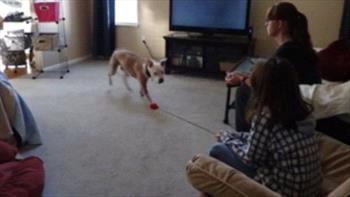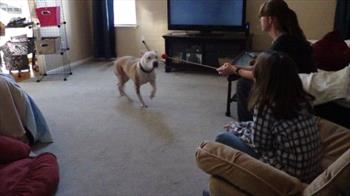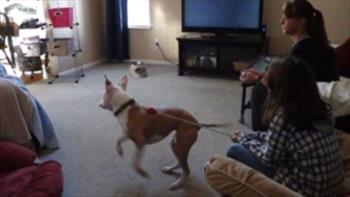At the San Francisco SPCA Behavior Resources Department, board certified veterinary behaviorist, Dr. Jeanine Berger, and her behavior technician, Lisa Stinnett, RVT, deal with fearful and aggressive dogs successfully on a regular basis. Their success is due in-part to their deep body of knowledge as well as a broad tool box. One important tool they use is the Treat&Train®—a remote controlled food reward system for training dogs and cats.
One unique way that they use the Treat&Train is to reward reactive dogs to become more comfortable around strangers in the home.
Behavior technician Lisa Stinnett explains, “The owner is instructed to play the target game in which the dog runs to touch the target with his nose and then runs back to the Treat&Train for his reward. They start several minutes before the guest is to arrive in order to put the dog in a positive emotional state. The dog is then placed in another room while the guest enters the home and settles into a chair. The guest is given the target stick and given instruction on what to expect and how to present the target based on the instructions from the Treat&Train tutorial. The dog is brought out on a leash and placed in a down-stay in front of the Treat&Train, which is several feet away from the guest. Then the guest is instructed to present the target.
While the dog is on leash with the owner, the dog goes to touch the target and returns back to the Treat&Train for his well-deserved reward.”
Interested in hearing more? So was I. Here are my questions and Lisa Stinnett’s answers.
Question:
What’s the benefit to using the Treat&Train here instead of the owner just giving treats by hand or having guests toss treats or use their hand as a target instead of a target stick?
Answer:
A majority of dogs are so food motivated that they will put themselves in a conflicting position just to gain that treat (meaning they will come too close even though they are a little uncomfortable at that distance). Then when the treat is gone they all of a sudden focus on the person or object that scares them and they react by barking, snapping, or lunging. That’s because dogs have a personal space bubble just as humans do and some have bigger space bubbles than others. And by respecting that personal space bubble by using the target stick, [humans can teach] the dog to trust them and enjoy the game. The target stick allows the dog to be further away from the person than if the dog targeted to the person’s hand directly. Additionally, the use of the Treat&Train, which is far away from the stranger, removes the pressure of being too close to the person in between treat dispensing. The dog also learns that he can easily remove himself to a more comfortable distance after the greeting.
Question:
What kind of dogs is this appropriate for? Can it be used for dogs who have bitten people?
Answer:
If a dog displays severe aggression towards strangers or has bitten before we recommend to consult with a Veterinary Behaviorist to design a complete and individualized treatment plan. Dogs bite for a variety of reasons and safety needs to be implemented first. The use of the Treat&Train is helpful for any dog that is fearful of strangers, including children. The leash keeps the dog at a comfortable distance and the target stick gives the dog something fun to focus on that allows him/her to indirectly be in the presence of a stranger while having fun. The dog is on leash for safety purposes to ensure that they can’t come into contact with the stranger. Additional safety for a very fearful dog can be achieved by placing the target several feet away from the guest at first or using a baby gate or x-pen around the person sitting in the chair to add that extra protection just in case the leash is dropped or the dog lunges and catches the owner off guard.
Question:
How do clients judge when their dog is doing well?
Answer:
If the dog is more focused on the stranger in the form of barking, growling or cowering while approaching the target stick, he/she is not ready for this step. The owner may need to take the target stick and sit half way between the stranger and the Treat&Train to see if the dog can perform the task of touching the target for the owner. Then gradually move a little closer to the stranger. As your dog relaxes you will see a change in their body movements and attitude toward the game. They may start out tense and unsure but as the game continues the dog will become more comfortable and start to enjoy themselves. Once the owner is close enough to pass the target stick to the stranger they can try again to see if the dog will target the stick with a more relaxed posture. One should only go as fast at the dog allows, and it is important to keep the sessions short at first.
Question:
How long should the session last and does it end with the dog interacting in other ways with the person or just being put back in its room?
Answer:
Sessions should be very short at first – 2–3 target touches then the dog should be removed to another room, crate, or tethered to the wall with a long lasting treat such as a Kong® or bully stick for about 10 minutes. Then you can do another session of 2–3 interactions. Gradually you can increase the number of interactions as the dog becomes more comfortable in the presence of the person. Because most people are just learning to be in tune with their dog’s body language we always have them start with 2–3 touches, then add 1–2 touches every session. If the dog is totally relaxed they can progress to decreasing the length of the target stick to allow the dog to get closer for 1–2 touches then add more touches each session. Gradually continue to decrease the length of the target stick until it can be replaced by the hand of the person. If the dog cannot perform the request or exhibits hesitation [the owner may be trying to progress too quickly] and need to slow down. No matter how relaxed the dog appears, any movement or unpredictability of the stranger can trigger the dog to react…so always remove the dog to a safe location before the stranger moves.
Because body language in dogs is so complex and humans can be very unpredictable with movements and intentions it is recommended that for any direct introductions (closer than 4 feet) between a reactive dog and a stranger, the client work closely with a Veterinary Behaviorist and a qualified trainer to walk them through the steps. The number of visits will depend on the severity of the reaction from the dog and the ability of the owner to implement the various training exercises.
Question:
Why is targeting better than just having dog lie at the Treat&Train and earn rewards for lying calmly when visitors enter
Answer:
The two exercises go hand in hand and are meant to complement each other. The “target” game is the next step up from having the dog comfortable on his mat being rewarded by the Treat&Train while in the presence of a stranger. Lying at the Treat&Train calmly helps the dog associate good things with the presence of a scary person or object. The target game helps to change the negative emotional reaction to the stranger by presenting the stranger in a fun and predictable manner so the emotional response is changed to a more positive one. The dog should be able to relax at a distance on their mat while in the presence of a stranger first, before beginning the intermediate steps of having your dog approach a stranger — which is accomplished by “target” the target stick while the stranger holds it! And during the sessions in between target touches the dog should happily lie in front of the Treat&Train to learn to relax in the presence of the stranger for various length of time.
Parting Words of Wisdom
One of the best parts of this SF SPCA protocol is that if you have a non-fearful or aggressive dog, you can use similar steps train your dog to be calm instead of hyperactive around guests! If you have a fearful dog and are planning to try this with or without supervision first pay attention to Stinette’s parting words of wisdom:
“Any behavior modification plan takes time, training steps and exposures to the trigger [should be] presented in very small amounts so the dog can succeed. The goal is to change the dog’s emotional responses to a trigger, not see how fast we can get the dog to be okay.”
The Treat&Train is a tool that really helps owners carry out the techniques. Says Stinnette, “the Treat&Train not only has multiple of uses for a variety of behavior problems, it also removes the pressure the owner may feel. [Now owners no longer need to worry about] coordinating treats and a multitude of other training tools. [And their] timing is much better so they can be quick enough with delivery to deliver treats before the dog gets nervous or reacts in a negative manner.”





